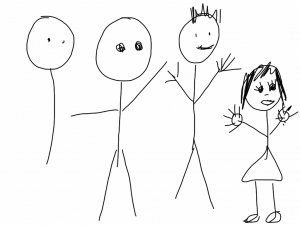As a former art teacher for many years, I was often asked by parents if I thought their child had talent in art. For many years I taught privately in my store and studio and I guess the parents were trying to justify the amount they were paying for lessons if they could be assured that yes, their child was indeed talented in art. The good news on kids activities and evaluating your child’s drawings is that ANYONE interested in art can learn it. It is an ability like learning to drive a car. You learn the technical aspects and then follow the steps and you are an artist whenever you decide to call yourself one. This is applicable to a person of any age. It is true, though, that it is easier to learn for people who are talented but the important thing to remember is that anyone can learn anything if the desire is there. Of the thousands of children I have taught, I quickly came to the conclusion that the desire or drive to learn is much more important than talent. I have had seen students that were talented but had no drive to learn and the students that did have a burning desire to learn art surpassed them in ability every time.
Evaluating a child’s drawings can be simple or complex. A good way to determine how advanced your child may be is to look at a drawing that is typical of the same age group of your child and then compare your child’s drawing. The more detail involved in the drawing the more advanced the child is in art.
Usually the child in the 1 – 5 year age range, will begin with a simple circle for the head and a straight line for the body resembling a tadpole and gradually add different body details as their drawing ability advances. A child talented in art will go through these same steps but faster and progress to adding other details to the picture. Encouraging a child to use a variety of media and having it readily available helps the child to advance to higher levels with their art. Their drawings can also be used to evaluate psychological and special needs if done randomly from the child’s subconscious mind. School counselors use this approach on a regular basis.Usually around the age of 10 a child becomes self-conscious and displeased with their drawings usually because of their desire to make it look more realistic. This can occur much quicker for the child that is talented. By evaluating your child’s drawing you can learn about their present developmental stage and by doing so encourage them to proceed to a higher level by offering suggestions of different media or different subject matter if they run out of ideas themselves.
Latest posts by Jan Watford (see all)
- Your First Time Hanging Out with Squirrly - April 23, 2019
- Jan C Watford Illustrations for 2017 - February 15, 2018
- My Illustrations Last Quarter of 2016 - February 15, 2017
